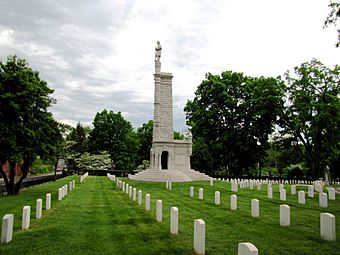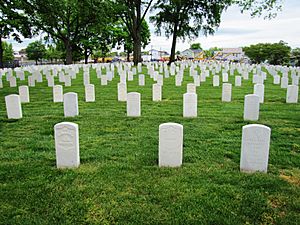Knoxville National Cemetery facts for kids
Quick facts for kids |
|
|
Knoxville National Cemetery
|
|

Union Soldier monument
|
|
| Location | 939 Tyson St., NW Knoxville, Tennessee |
|---|---|
| MPS | Civil War Era National Cemeteries MPS |
| NRHP reference No. | 96000966 |
| Added to NRHP | September 12, 1996 |
Knoxville National Cemetery is a special burial ground in Knoxville, Tennessee, USA. It was created during the American Civil War in 1863. This cemetery covers about 9.8 acres and, by 2007, held 9,006 burials.
A tall, 60-foot monument to Union soldiers stands here. It is one of the biggest Union monuments in the Southern states. In 1996, the cemetery became a part of the National Register of Historic Places. This means it is recognized as an important historical site.
Contents
History of the Cemetery
Knoxville National Cemetery was started by Major General Ambrose Burnside. His Union army freed Knoxville in September 1863. This happened during the peak of the American Civil War.
General Burnside asked Captain E.B. Chamberlain to design the cemetery. Captain Chamberlain was his assistant quartermaster. The first people buried here were Union soldiers. Their bodies were moved from places like Cumberland Gap and other nearby areas. Chamberlain's design was so good that it hardly needed any changes. It became a national cemetery right after the war ended.
Exploring the Cemetery's Layout
The graves at Knoxville National Cemetery are set up in a circle. Walkways separate each section where people are buried. Each burial section forms one-quarter of the circle. The headstones all face towards the middle. In the center, there is a flagpole and a cloth canopy.
A stone wall goes all around the cemetery. Part of this wall separates the cemetery from the Old Gray Cemetery next door. The main entrance is on the northeast side of the wall. This part has an iron fence on top and a large iron double-gate.
Right inside the gate, you will find the office building. A special marker faces the graves in the northeast corner. It has lines from a famous poem called Bivouac of the Dead by Theodore O'Hara.
Most of the grave markers are standard marble headstones. Some, however, are larger and more detailed. The markers usually show the person's name and the years they lived. Sometimes, they also show their military rank or the war they fought in. Only veterans and their spouses can be buried here. After the Civil War, only Union soldiers were accepted. However, at least one Confederate grave is present. Today, the cemetery is managed by Mountain Home National Cemetery. It holds veterans from every war since the Civil War.
The Union Soldier Monument
The Union Soldier monument is in the eastern part of the cemetery. It was built in the early 1900s. In 1892, Confederate veterans in Knoxville built their own monument. It was 48 feet tall and had a statue of a Confederate soldier. This monument was near the Mabry–Hazen House.
Not wanting to be outdone, the local Grand Army of the Republic (GAR) group decided to build a bigger monument. This group was for Union veterans. They formed a committee led by William Rule. He was a former Union Army officer and a newspaper publisher. Their goal was to raise money for a larger monument at Knoxville National Cemetery.
The monument was finished in 1901. It was first 50 feet tall, taller than the Confederate monument. A bronze eagle with spread wings sat on top. But on August 22, 1904, lightning struck the eagle. The sound was so loud it shook Knoxville and could be heard for miles.
The GAR commissioners were not discouraged. They quickly planned to rebuild it. They got money from the government with help from Congressman Henry R. Gibson. The new monument was designed by Baumann Brothers, a local architecture firm. It looked much like the first one. However, instead of an eagle, a marble statue of a Union soldier was placed on top. The new monument was completed on October 15, 1906.
The monument is made of Tennessee marble, which is found locally. It looks like a medieval fortress. It has stained glass windows and a room inside with a staircase. The 8-foot soldier statue stands on top of the main tower. Some people call it the "Wilder Monument." This is because a local story says the soldier looks like Union general John T. Wilder.
Notable People Buried Here
Many important people are buried at Knoxville National Cemetery.
Medal of Honor Recipients
- Sergeant Troy A. McGill (1914–1944): He received the Medal of Honor for his brave actions in World War II.
- Private Timothy Spillane (1842–1901): He earned the Medal of Honor for his actions at the Battle of Hatcher's Run during the Civil War.
Other Important Figures
- Brevet Major General Joseph Alexander Cooper (1823–1910): He was a veteran of both the Mexican–American War and the U.S. Civil War.
- Brigadier General Robert Neyland (1892–1962): He fought in World War I and World War II. He was an aide to Douglas MacArthur. Later, he was the superintendent of West Point. Neyland was also the head coach for the Tennessee Volunteers football team. Neyland Stadium is named after him.



